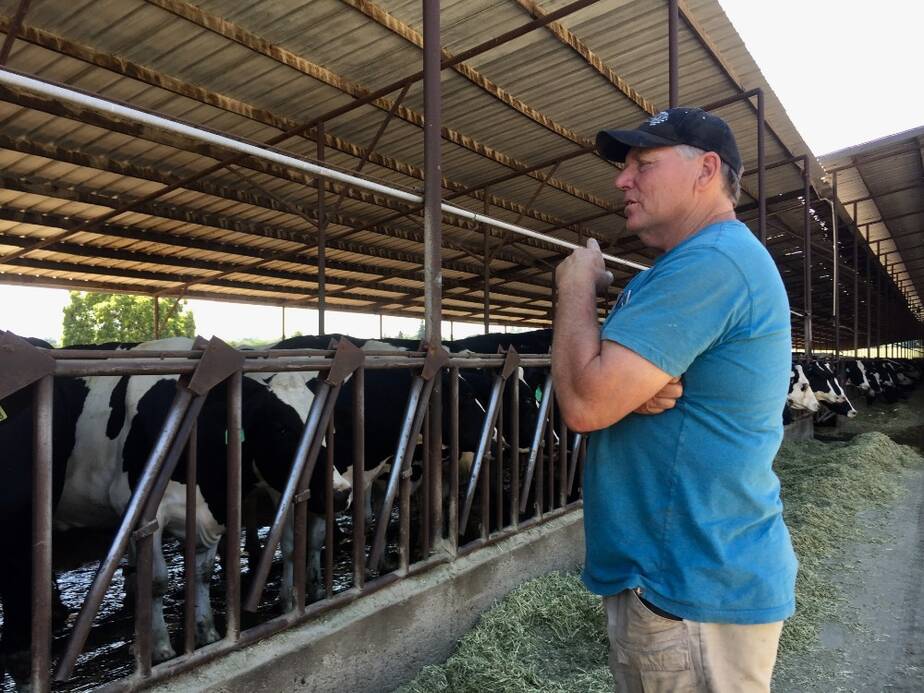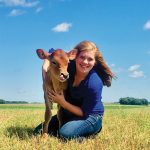
After 67 years of living and breathing dairy farming in California’s San Joaquin Valley, Scott Magneson cannot, will not, stop.
Every morning before dawn, when the valley fog is still resting on his fields in thick clouds, he checks the barns. Then he starts on the to-do list, which outlasts the day. In another farm tradition, Magneson rarely leaves his land. He can’t remember the last time he and his wife Pat (who does the bookkeeping) took a vacation.
Magneson, a big, ruddy-faced man who has earned his broad shoulders, is working all he can to ensure his farm—with 600 Holsteins, 500 acres, and 12 full and part-time workers—survives wildly uncertain times.
Two years ago, in a major conservation move, he added a $560,000 manure management and composting system, paid for by a state grant for “climate smart” agriculture projects. It’s a hopeful investment for the future, against the odds. Even before the coronavirus blindsided the world and upended the food delivery system, the iconic American family farm was already in crisis, its ranks shrinking before his eyes.
When Magneson was growing up, the vast dairy lands of Merced County, two hours south of San Francisco, stretched to the horizon. Everyone farmed. It was always hard work, but also proud. These days, farmers are spent. The decades-long decline in multi-generational family farms is quickening. Studies blame climate change, at least partly. Record heat, severe drought, biblical floods and historic wildfires are hitting too hard, too often, for farms to recover from the blows.
Ironically, dairy farms, a significant source of climate-changing emissions in the form of methane gas from cow effusions, are failing the fastest. Besides freakish weather events, they are being pummeled by declining milk prices, rising production costs, trade war tariffs on milk exports and the growth in mega dairies.
More than half the nation’s dairies have disappeared in the last 15 years, dropping from more than 70,000 to just over 34,000. Last year, 3,281 dairy farms disappeared, the largest annual drop since 2004. California, the top dairy state, lost 80 farms last year and more than 800 in the last 20 years, leaving 1300.
Despite the precipitous drop in family farms, the number of milk cows has ticked up. Farm closures are fueling consolidations, creating industrial operations with several thousand cows. The largest in the country thus far, 75 miles north of Chicago, has 30,000 cows.
A grim consequence of the farm failures is suicides. Dairy farmers are killing themselves at twice the rate of veterans and five times that of the general public.
The coronavirus, still playing out, is adding to the disaster for family farms, even with Federal and local farm aid. In dramatic videos, the world has watched farmers dumping thousands of gallons of milk because their primary customers, schools and businesses, were locked down. The dramatic, literal loss of their product underscores their dire predicament. Even milk producers who haven’t had to spill a drop of milk, Magneson included, have written off the year in red ink. .
Magneson has lost 20 percent of his business since the pandemic lockdowns, sold 30 of his cows and has been forced to sell his milk, which is organic, at a loss.
“Every once in a while, I’ve thought about doing something else,” he said, shrugging. He was walking through a barn with his son Jake, 27, as cows poked their heads through stalls to watch them.
Climate-Friendly Agriculture
Jake works on the farm too, handling complicated paperwork such as grant applications for projects to reduce the farm’s methane emissions. A 2016, California law requires livestock farms to cut methane emissions by 40 percent of 2013 levels by 2030—with dairy farms bearing 75 percent of the burden.
To help meet the state’s ambitious goal to drastically reduce its greenhouse gases, California launched the country’s first “Climate Smart Agriculture Programs” in 2014. Four programs provide funds, education and support for farmers committed to cleaner, greener land conservation, water efficiency, healthy soils and alternative manure management.The programs, launched by the California Department of Food and Agriculture (C.D.F.A.), are so popular, that two to three times as many farmers have applied than the program can sustain.
Jake’s application for the manure solids separator landed the farm one of the state’s first Alternative Manure Management Program (or AMMP) grants in 2017. (Scott Magneson describes the project in this C.D.F.A. video: https://www.youtube.com/watch?v=537nfqC_q2U).
Their elaborate system looks like a giant sized Rube Goldberg machine, but all the parts serve the same purpose—to reduce waste, create organic compost to use on the land, provide bedding for the cows and create richer, more productive soil.
“Thank goodness we have politicians who believe in science,” Scott Magneson said, referring to California’s former governor Jerry Brown and Gov. Gavin Newsom. He was running his fingers through clean compost heaps as if they were gold.
His dairy is setting the example for how dairies can reduce their pollution impacts, improve animal welfare, cut waste and become more resilient, said Renata Brillinger, executive director of the California Climate and Agriculture Network (CalCAN).
“What I see with Scott Magneson’s farm is what the future of climate friendly sustainable agriculture can look like,” she said. “You have better conditions for the animals, better conditions for the farmers and farmworkers. Better air quality, better water quality and the production of compost, which is a really valuable product.”
The typical way farmers handle manure is to flush their cows’ stalls out into lagoons or ponds. The solids settle to the bottom and float throughout the water, then become anaerobic. That manure decomposes and off-gases methane.
Even the most sustainable farms still use lagoons, Brillinger said, because of the cost of solid separators and dairy digesters, which convert manure into fuel. Dairy digesters, used by only 12 farms in California, trap methane before it reaches the atmosphere and convert it to natural gas. The digesters are controversial among environmentalists because one-quarter of the emissions that contribute to global warming come from natural gas, which can leak from pipelines and do untold damage.
The way the Magnesons handle manure these days is to flush the stalls out into settling ponds, then pull some of the solids out of the pond. After running them through the separator, the solids drop it down to a compost pad. The ponds are left with much cleaner water that can be reused.
The Magnesons also bought a compost pack barn with their grant. Like luxury hotels for lactating cows, compost pack barns, still rare in California, house cows in large open resting areas, usually bedded with sawdust or dry, fine wood shavings, with manure composted into place and mechanically stirred on a regular basis. The cows have access to indoor and outdoor areas.
The climate smart agriculture programs may be a hit, but funding is in jeopardy. With California facing an up to $54 billion deficit, several projects, including the alternative manure management program, may not be funded next year.
The program is funded by California’s cap-and-trade program, in which major polluters have emissions quotas that ratchet down over the years. To comply, they can either cut their emissions or buy allowances from others as offsets. They pay into the program based on their emissions. But this pandemic year, with fuel use and production down, the money in the fund has been drastically reduced, from a usual $600 to $800 million in the first quarter of the year to $25 million.
An Early Adopter
The dairy industry fought for years to spare farms from being forced to help mitigate the environmental impact of their milk producers. But the Magnesons fully support the efforts. Even before Brown made reducing climate change his signature issue, Scott Magneson began making changes to the farm to lessen its environmental load. .
In 2004, he put a permanent concrete easement on the property, which sits on the banks of the Merced River, a move conservationists recommend to protect clean water and preserve open space. He converted the farm to organic production in 2008 for healthier milk, cows and soil.
In truth, Magneson has never really considered quitting the farm. One major reason is his son, whom he expects to lead the farm someday. His father and his father’s father are other reasons.
Preserving his legacy still means something. The Magneson Dairy, deep in California’s most prolific growing region, has been part of the landscape of crops and cows on the banks of the Merced River for 120 years. His mother, who is over 90, still lives there. So does Jake, who attended nearby Stanislaus State University and never considered another career. (He majored in philosophy.)
In unincorporated Ballico, a town in name only, two hours south of San Francisco where the whiff of manure is a given, no one knows a time when the Magneson Dairy didn’t exist. To Magneson, it’s a sacred trust. None of his siblings—three sisters and three brothers—were interested in taking over when their father was ready to hand them the keys to the farm.
He’s got a sure successor in his son. He and his wife are taking care of their two grandsons, 6 and 11, who already know a lot about how the farm operates. They might become the fifth generation to run the farm, or at least own a piece of it.
“I’ve seen a thousand farms go,” he said, letting out a sigh of mourning for his brethren. “What we’re doing is to ensure we don’t end up like them.”

























